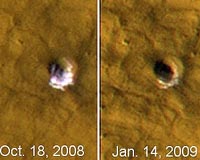 |
Washington (AFP) Nov 23, 2009 A new detailed map of Mars shows what was likely a vast ocean in the north and valleys around the equator, suggesting that the planet once had a humid, rainy climate, according to research published Monday. The computer-generated map, based on topographic data from NASA satellites, also shows that the network of valleys on the red planet is at least twice as extensive as previously estimated. "The relatively high values over extended regions indicate the valleys originated by means of precipitation-fed runoff erosion -- the same process that is responsible for formation of the bulk of valleys on our planet," said Wei Luo, geography professor at Northern Illinois University who co-authored the report. "A single ocean in the northern hemisphere would explain why there is a southern limit to the presence of valley networks," Luo said. "The southernmost regions of Mars, located farthest from the water reservoir, would get little rainfall and would develop no valleys. This would also explain why the valleys become shallower as you go from north to south, which is the case." Rain, said Luo, "would be mostly restricted to the area over the ocean and to the land surfaces in the immediate vicinity, which correlates with the belt-like pattern of valley dissection seen in our new map." The report appears in the Journal of Geophysical Research. Since NASA's Mariner 9 space probe discovered the ancient Martian valley networks in 1971, debate has raged over whether the valleys resulted from water erosion -- meaning that there was humidity and rainfall -- or through groundwater sapping erosion, which can happen in cold and dry conditions. Luo worked is co-author of the report along with Tomasz Stepinski, a staff scientist at the Lunar and Planetary Institute in Houston, Texas. Share This Article With Planet Earth
Related Links Mars News and Information at MarsDaily.com Lunar Dreams and more
 Scientists See Water Ice In Fresh Craters On Mars
Scientists See Water Ice In Fresh Craters On MarsTempe AZ (SPX) Sep 25, 2009 Scientists are seeing sub-surface water ice that may be 99 percent pure halfway between the north pole and the equator on Mars, thanks to quick-turnaround observations from orbit of fresh meteorite impact craters on the planet. "We knew there was ice below the surface at high latitudes of Mars, but we find that it extends far closer to the equator than you would think, based on ... read more |
|
| The content herein, unless otherwise known to be public domain, are Copyright 1995-2009 - SpaceDaily. AFP and UPI Wire Stories are copyright Agence France-Presse and United Press International. ESA Portal Reports are copyright European Space Agency. All NASA sourced material is public domain. Additional copyrights may apply in whole or part to other bona fide parties. Advertising does not imply endorsement,agreement or approval of any opinions, statements or information provided by SpaceDaily on any Web page published or hosted by SpaceDaily. Privacy Statement |